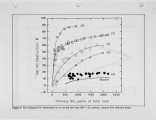| Abstract |
A bench-scale, laminar, counter-flow, diffusion flame was used to explore the destruction of NOx during reburying. A flame such as this may be considered to be a prototype for the stretched diffusion flamelets that occur in large turbulent diffusion flames in boilers. The study was motivated by field data which suggested that large boiler demonstrations of reburying, where unmixedness cannot be avoided, were more successful at destroying NO than pilot scale experiments where mixing was more rapid. Furthermore, the field data, but not the pilot plant data, showed that reburying might be effective under overall fuel lean conditions, in the reburying zone, which are more benign for boiler operation. Therefore, we focused on NO destruction under overall fuel lean environments, and flue gas and fuel were emulated by an oxidant mixture of NO, O2, CO2, and N2, and by CH4, diluted by N2, respectively. We found that very large destructions of NO were possible, depending on how the NO contacted the diffusion flame zone. In general, efficient destruction (exceeding 90%) of NO occurred primarily when there was a concentration gradient of NO along the same plane as the reaction zone, as in a two dimensional co-flowing, rather than a one dimensional counter-flowing diffusion flame configuration. For the counter-flow flame, detailed axial profiles of temperature, major species and nitrogenous species were measured. These compared very well well with those predicted by a one dimensional model which employed detailed chemical kinetics. However, without an annular shroud gas to quench reactions in the sheared co-flowing portion of the flame, the flat, one dimensional, part of the flame so modeled was shown to account for only a small fraction of the overall destruction of NO measured. A much more important destruction of NO occurred in that portion of the flame in which the NO containing oxidant and fuel streams were in a coflow, rather than counter-flow configuration. These experimental and theoretical results have both fundamental and practical significance. On the fundamental side, the good agreement between detailed kinetic modeling and measured axial profiles for the flat opposed flow diffusion flame, shows that the kinetics of NO destruction by hydrocarbons, over a wide range of local stoichiometries, are now well understood. On the practical side, the experimental results show that very large destructions of NO are possible under overall fuel lean conditions, if turbulent mixing between reburying fuel and flue gas oxygen can be hindered. This has practical implications for new effective applications of reburying in boilers. |




















